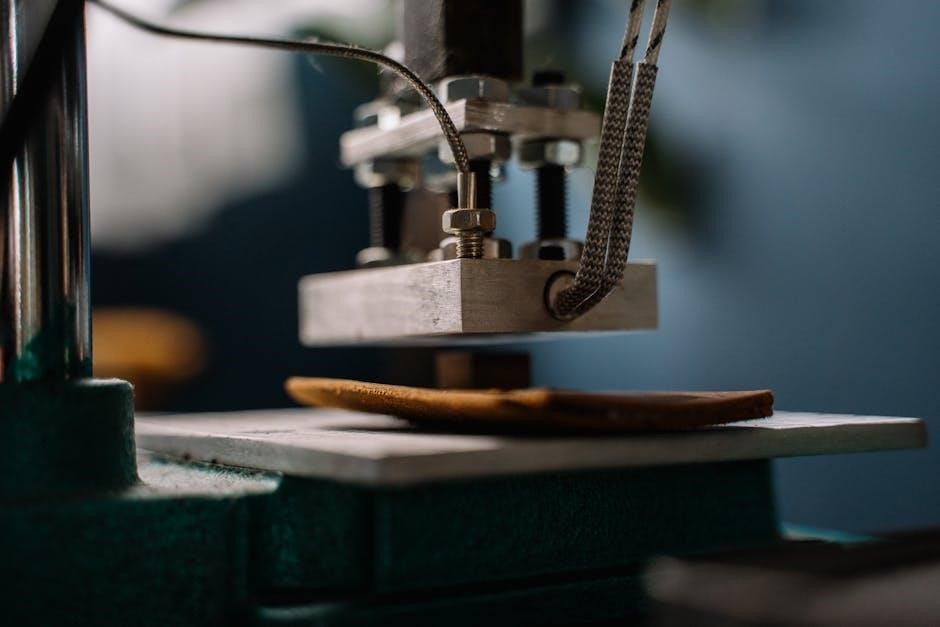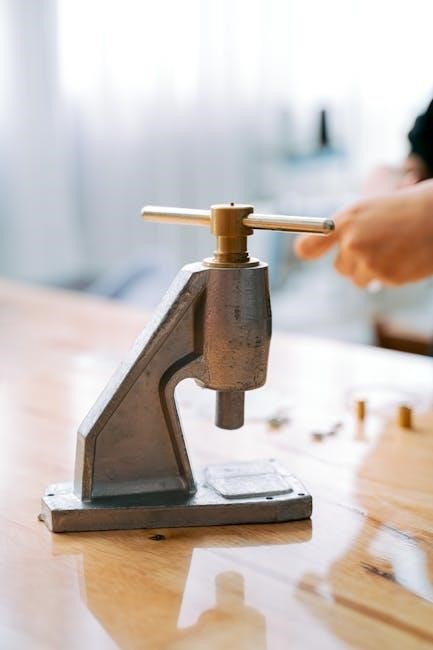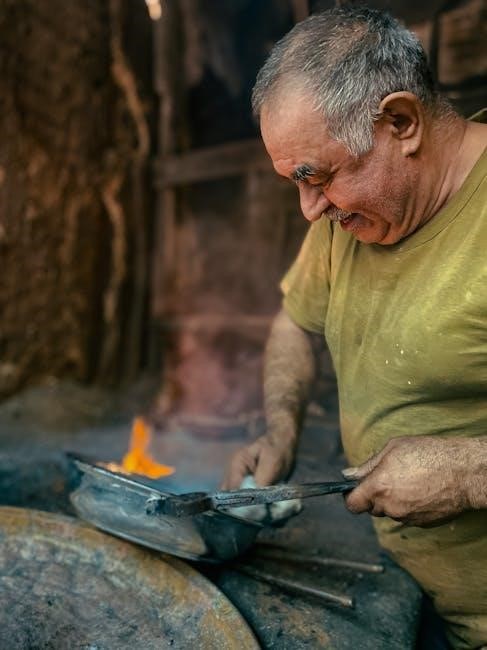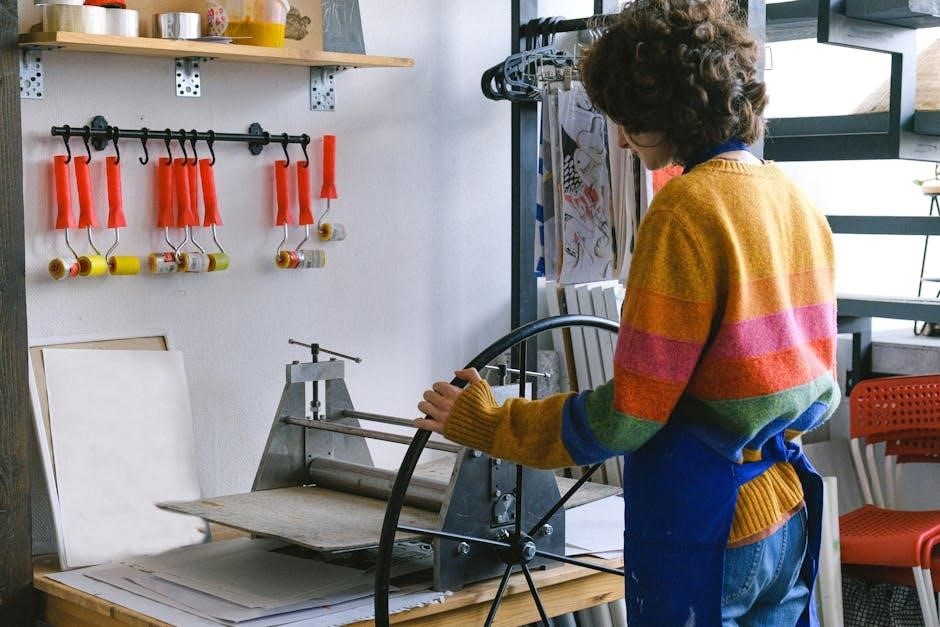A heat press is a machine that transfers designs onto materials using heat and pressure, commonly used for customizing fabrics, plastics, and metals․ It is essential for crafters and small businesses, offering versatility and efficiency in creating personalized items․ The device operates by applying electric heating, precise temperature control, and adjustable pressure to ensure even transfers․ Available in various sizes and types, it supports diverse applications, from textiles to sublimation printing, making it a versatile tool for creative projects․
1․1 What is a Heat Press?
A heat press is a machine that transfers designs onto materials using heat, pressure, and time․ It is electrically heated, with adjustable temperature and pressure controls, suitable for various materials like fabrics, plastics, and metals․ The device is versatile, accommodating different transfer techniques such as sublimation, screen printing, and vinyl application․ Its design includes a heating plate, pressure distribution system, and digital controls for precise operation․ Widely used in crafting, textiles, and manufacturing, it is a reliable tool for creating custom designs efficiently and professionally․
1․2 Uses of a Heat Press

A heat press is versatile, enabling the transfer of designs onto various materials such as fabrics, plastics, and metals․ It is commonly used for customizing t-shirts, mugs, and phone cases․ Hobbyists and businesses alike utilize it for sublimation printing, vinyl application, and heat transfers․ The machine is ideal for creating personalized items like apparel, accessories, and promotional products․ Its adaptability makes it a valuable tool for both small-scale crafting and industrial production, catering to diverse creative and commercial needs effectively․

Key Components of a Heat Press
The heat press comprises essential components like the heating plate, temperature control, pressure adjustment, digital timer, and alarm system, ensuring precise and safe design transfers․
2;1 Heating Plate and Temperature Control
The heating plate is a crucial part of the heat press, typically made of thick, durable materials like aluminum for even heat distribution․ It is designed to reach high temperatures, often up to 450°F (232°C), and features precise digital temperature control․ This component ensures consistent heat application, which is vital for successful transfers․ The temperature control system allows users to set and maintain the exact heat required for various materials, preventing damage and ensuring optimal results․ Proper calibration and regular maintenance of the heating plate are essential for longevity and performance․
2․2 Pressure Adjustment and Even Distribution
The heat press features an adjustable pressure system, allowing users to customize the force applied based on the material thickness and type․ Manual models often include a screw or dial mechanism for precise control, ensuring even pressure distribution across the heating plate․ This feature is particularly useful for materials like puff vinyl, which require specific pressure levels․ The swing-top design enhances accessibility, making it easier to adjust pressure evenly․ Proper pressure adjustment is critical to avoid over-application, which can damage materials or cause uneven transfers, ensuring professional-grade results in various printing projects․
2․3 Digital Timer and Alarm System
The digital timer and alarm system on a heat press ensures precise control over the pressing time, ranging from 0 to 999 seconds․ This feature allows users to set specific durations for different materials, preventing overheating or underheating․ The alarm sounds when the timer expires, alerting the user to stop the process․ Some advanced models include automatic shut-off and countdown functionality, enhancing safety and efficiency․ This system is crucial for achieving consistent results in heat transfer applications, ensuring designs are applied correctly without damage to the material or the machine․
How to Use a Heat Press Machine
Plug in the machine, set the temperature, and preheat․ Place the material on the lower plate, add the design, and adjust pressure․ Use the timer for accurate results, ensuring safety and efficiency․
3․1 Preparing the Machine
Before using the heat press, ensure it is placed on a stable, heat-resistant surface and plugged into a suitable power source․ Preheat the machine to the desired temperature, allowing it to reach the set level for optimal performance․ Clean the heating plate and base to prevent any residues from affecting transfers․ Position the material or substrate on the lower plate, smoothing it to avoid wrinkles․ Ensure all accessories, like protective sheets or parchment paper, are ready․ Proper preparation ensures a smooth and successful transfer process․
3․2 Setting the Correct Temperature and Time
Setting the correct temperature and time is crucial for achieving optimal results with a heat press․ The temperature range typically spans from 0-450°F, with specific settings depending on the material․ Cotton may require lower temperatures, while synthetic materials like polyester need higher heat․ Time settings generally range from 10 to 20 seconds, varying by material and transfer type․ Sublimation printing might require longer durations․ Utilize the digital timer and alarm system for precise control, ensuring even heat distribution․ Preheating the machine is essential for consistent transfers․ Always refer to the manual for material-specific guidelines to ensure safety and professional-quality outcomes․
3․3 Placing the Material and Design
Properly placing the material and design is essential for successful heat transfer․ Ensure the design is centered on the material, using alignment tools like a laser pointer or grid for accuracy․ Smooth out wrinkles in the fabric to prevent air pockets․ Place the design face-down on the material, securing it with thermal tape if needed․ Close the heat press gently, avoiding uneven pressure․ Double-check the placement before applying heat to ensure the design aligns correctly․ Proper alignment ensures a professional finish, preventing misregistration and wasted materials․ Always pre-test placement on a small sample for best results․

3․4 Applying Pressure and Monitoring the Process
Once the material and design are in place, close the heat press firmly, ensuring even pressure distribution․ Adjust the pressure knob to the recommended setting for your material type․ Use the swing top or drawdown mechanism to secure the design tightly․ Monitor the timer and temperature closely to avoid overheating․ When the alarm sounds, open the press carefully to inspect the transfer․ Proper pressure ensures a crisp, durable finish․ Always wear gloves to protect from heat and sharp edges․ Allow the material to cool slightly before handling to prevent damage or distortion․
Safety Precautions
Always wear protective gloves and safety glasses to avoid burns and injuries․ Ensure proper ventilation to prevent inhaling fumes․ Keep children away and never leave the machine unattended while in operation․ Regularly inspect cables and heating elements for damage․ Avoid touching hot surfaces and follow the manual’s guidelines for safe usage․ Maintain a clean workspace to reduce fire hazards․ Never overload the machine, as this can cause malfunctions․ Always unplug the device when not in use or during maintenance․
4․1 Avoiding Burns and Injuries
Always wear heat-resistant gloves and safety glasses when operating a heat press to protect against burns and injuries․ Ensure the machine is placed on a stable, heat-resistant surface․ Never touch the heating plate or press surfaces during operation, as they reach extremely high temperatures․ Keep children and pets away from the workspace․ Avoid wearing loose clothing that could get caught in the machine․ Proper ventilation is essential to prevent inhaling fumes from materials like vinyl or sublimation inks․ Regularly inspect cables and heating elements for damage to prevent electrical hazards․ Follow the manual’s safety guidelines meticulously to minimize risks․
4․2 Proper Ventilation and Workspace Setup
Ensure your workspace is well-ventilated to prevent inhaling fumes from materials like vinyl or sublimation inks․ Place the heat press on a heat-resistant, flat surface away from flammable materials․ Keep a fire extinguisher nearby for emergencies․ Maintain a clean and clutter-free area to avoid accidents․ Position the machine in a well-lit space to monitor operations clearly․ Use a thermal-insulated table or mat to protect surfaces from heat damage․ Proper workspace setup enhances safety, efficiency, and the quality of your heat press projects․ Always follow manual guidelines for optimal workspace configuration․

Maintenance and Troubleshooting
Regularly clean the heat press plates and lubricate moving parts to ensure smooth operation․ Check for loose connections and resolve temperature or pressure issues promptly for optimal performance․
5․1 Cleaning and Lubricating the Machine
Regular cleaning and lubrication are crucial for maintaining the heat press’s efficiency․ Use a soft cloth to wipe away residue from the plates and frame․ Apply a silicone-based lubricant to moving parts like hinges and sliding components to ensure smooth operation․ Avoid using harsh chemicals or abrasive materials that could damage the machine․ Proper maintenance prevents rust and wear, extending the lifespan of the heat press and ensuring consistent performance․
5․2 Resolving Common Issues
Common heat press issues include uneven pressure, temperature fluctuations, and material jamming․ Check alignment and tighten bolts if pressure is uneven․ For temperature inconsistencies, ensure the thermostat is functioning correctly and replace faulty heating elements․ If materials stick, adjust settings or use a release sheet․ Lubricate moving parts if the machine jams․ Regularly inspect and clean the heat plate to prevent residue buildup․ Refer to the manual for troubleshooting specific error codes or unusual noises․ Addressing these issues promptly ensures optimal performance and prevents further damage to the machine or your projects․
Advanced Techniques
Explore advanced methods like sublimation printing for vibrant, full-color designs and working with diverse materials to expand your creative possibilities․ Experiment with multi-layered transfers and specialty inks․ Use timing and temperature adjustments to achieve unique effects․ Incorporate foil stamping for metallic finishes or texture transfers for added depth․ These techniques enhance your projects, offering professional-grade results and opening new opportunities for customization and innovation in various mediums․
6․1 Sublimation Printing
Sublimation printing is an advanced technique that uses heat to transfer dye onto materials like fabric, ceramic, and metal․ It involves printing designs onto transfer paper, which is then placed under the heat press․ The machine applies high temperatures (up to 450°F) and pressure to convert the dye into gas, ensuring vibrant, long-lasting colors․ This method is ideal for full-color designs and photorealistic images․ Proper temperature, time, and pressure settings are crucial for optimal results․ Sublimation printing is widely used for customizing items like mugs, phone cases, and textiles, offering professional-grade outcomes with minimal effort․
6․2 Working with Different Materials
A heat press can be used with various materials, including fabrics, plastics, metals, and ceramics․ For fabrics, cotton and polyester are common choices, while sublimation printing works well on polymer-coated surfaces; Adjusting temperature and pressure settings is essential for different materials to achieve the best results․ Higher temperatures are often required for thick or dense materials, while delicate fabrics may need lower settings․ Proper preparation of the material, such as preheating, ensures even transfer and prevents damage․ Experimenting with different materials allows for creative and durable custom designs, making the heat press a versatile tool for diverse applications․
